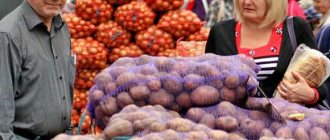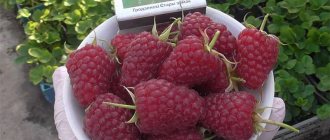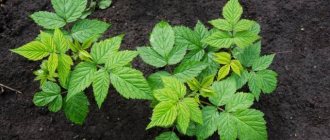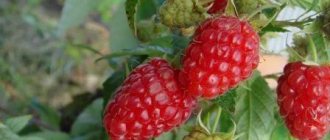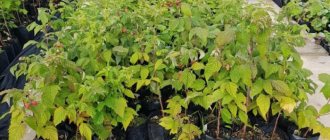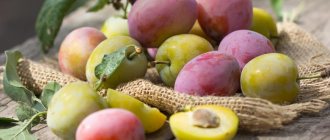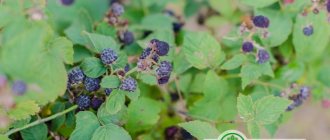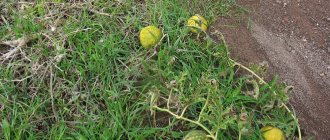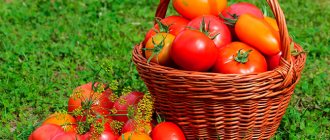For the northwest
Let's consider the main varieties according to their ripening speed, so that summer residents can choose the best option for their plot, taking into account their own preferences.
Early ripening
The following varieties ripen quite early:
- Credo is a low-growing raspberry that ripens around the beginning of June. The stems are straight, there are practically no leaves on the branches, which is very favorable for a region with frequently changing weather.
- Meteor also ripens early. In this case, all the berries turn red at about the same time. Excellent immunity and excellent frost resistance make this variety very popular in the Leningrad region. The berries are sweet, you can get up to 4 kg from one bush.
- Sunshine is a very popular variety. It produces up to 3 kg of berries per bush. The fruits are very sweet and have good keeping quality. The culture itself is immune to most diseases and can survive fairly harsh winters.
These are the main varieties that ripen early and are grown in the Leningrad region. Although, you can find a number of others that are also very popular among gardeners.
Average
Around the beginning of July, you can harvest the following varieties:
- Vera - bred in Siberia, is frost-resistant. The berries are sweet, but with a slight sourness. You can collect up to 4 kg from one bush. The bush produces a large number of side shoots with sharp thorns, so the berries can be difficult to collect.
- Kuzmin's news - produces fruits of 2-3 grams each. The bushes are small, their maximum height reaches two meters. The culture tolerates wet soil and frost well. The berries are cone-shaped and raspberry-colored. From one bush you can harvest more than 2 kg of crop.
- Barnaul raspberry is another Siberian raspberry that is often grown in regions with harsh climates. The berries are red, with a slight shine, weigh 2–3 grams. Low aroma, even ripening. The tops of the shoots can sometimes freeze, but they need to be cut off with garden shears.
Read also: Unusual master class for the competition
Late
Here are the main varieties that ripen when others have already lost their raspberries:
- Diamond - has no thorns and has fairly large berries. They shine, that’s why the variety is called that. The culture is unpretentious, so it is often chosen for cultivation by gardeners in the Leningrad region.
- Eurasia is another popular variety that is great for northern regions. It is frost-resistant and produces up to 3 kg of yield per bush. The height of the shoots is about 1.8 meters. The harvested crop can be stored for up to two weeks, after which it begins to rot if it is not processed. The first berries appear around mid-August, and fruiting occurs before frost.
- Coral - has shoots up to two meters high. Annual branches are green at first, but turn purple by autumn. There are some thorns. The harvest is up to 3 kg per bush, each berry weighs about 3 grams. The fruits have the shape of a wide cone. The pulp is sweet and aromatic.
Growing conditions and soil
Raspberries grow well when they are planted on the south side of buildings - a house, barn or bathhouse. It’s even better if the landing site is illuminated by the sun all day. This is ideal, as experts recommend. But, if it is not possible to plant raspberries in a sunny place, then you can get by with partial shade. My raspberries grow along the southern border of the plot, illuminated by diffused sunlight - on the northern side there is a neighbor’s greenhouse and house.
If the soil in the area is swampy, then it is better to plant raspberries in beds. This is how it was done on our neighbors’ property - the bed is level, excess water flows into a drainage ditch, the raspberries themselves are a sight to behold. Raspberries also do not like places that are too dry, so when there is no rain for a long time, they need to be watered.
Special conversation about soil. The soil should be loose, manured, neutral, that is, not acidic. Therefore, we pay special attention to soil preparation. We dig a ridge 1.2 m wide to the clay. In the middle of the ridge, across its entire width, we dig a groove in the clay “for the bayonet of a shovel.” We fill this groove with half-rotten roots and sprinkle with dolomite flour. During rainy summers, excess water will be drained from the garden bed along this ditch.
For each meter of ridge we add two buckets of rotted manure, a bucket of river sand, two buckets of peat, sprinkle everything with dolomite flour and add ash.
It is good to loosen the soil with sawdust, but it must be rotted. They lie in heaps for 2–3 years, and only after this period do we bring them into the beds. It is advisable to select all the weeds. If left in the soil, a small root of a ubiquitous weed will grow again into a lush plant. Selecting it from raspberry plantings after planting is a difficult task.
We plant raspberries in two rows in spring or autumn, the distance between rows is 0.7 m, between bushes - 0.5 m. In autumn, the best planting time is late September - early October. For the third year now, autumn has been warm, with even temperatures, without frost. During October, the seedling manages to take root and quickly grows in the spring. When planting, leave 3-4 buds. The buds at the roots, basal buds, should be in the ground.
Usually seedlings are bought at exhibitions. If the raspberries are remontant, then the seedlings are even sold with berries. You can immediately, upon purchase, prune the seedlings to five buds from the root, and when planting, to another four. Then you won’t have to carry heavy one and a half meter bushes.
If you were unable to plant raspberries in the fall, dig the bush until spring. I usually, if I don’t have enough time for planting, plant the seedling immediately in a five-liter plastic container. For the winter, I dig the balloon in at an angle and cover it with spruce branches, and in the spring, before the buds open, I dig it up and put it in a sunny place - let it grow until planting. I plant them when I have free time. The good thing about container plantings is that they can be planted at any time - spring, summer or autumn. But raspberry seedlings with an open root system should be planted in early spring, before the buds open. After planting, the bushes are watered abundantly and mulched with peat, humus or rotted sawdust.
I fertilize raspberries 3-4 times a season, and only with organic matter. In the spring, in April, I pour mullein infusion. I fill the bucket halfway with mullein, let it brew for two weeks, then dilute 1 liter of this infusion in 10 liters of water. Approximate consumption: one watering can per 1 sq.m of bed. After this, the soil is mulched with rotted sawdust. I do this in April until the raspberries sprout new shoots.
After three weeks, I fertilize with either green fertilizer or infusion of chicken manure. I infuse chicken manure, just like mullein, for two weeks, diluting 0.5 liters of infusion in 10 liters of water.
Green fertilizer can be harvested from mid-spring. I fill a two-hundred-liter barrel one-third with mullein or humus, fill it to the top with weeded weeds, fill it with water, close the lid and leave for two weeks. Green fertilizer is ready for the whole summer. We dilute 1 liter of infusion in 10 liters of water.
In the second half of summer, the bushes can be fed with an infusion of ash, but due to lack of time, I simply spray the ash. And in the fall I mulch the plantings again with humus or rotted sawdust.
It is also important to remove the growth on time. On last year's bushes, 5 or 6 shoots should be left for fruiting. In the spring, shoots begin to grow that will bear fruit next year. They also need to be left 5 or 6. The rest need to be broken out when they are still very small.
Read also: How to prepare soil for planting cucumbers in open ground in
It’s even easier with remontant varieties. We leave 5 or 6 shoots in each bush. We break out the rest.
Repairers: how to choose the best?
It is possible to choose any frost-resistant variety that can produce a good harvest. However, when purchasing seedlings, you need to pay attention to some factors:
- they must be painted in a typical color;
- the root system should be quite developed;
- the escape itself must be strong.
When inspecting a seedling, it is very important to pay attention to the presence of rot or other diseases. So, in the nursery, almost 90% of the shoots are infected with one or another disease. Therefore, after purchasing a seedling, it should be quarantined . That is, it must grow separately from the main raspberry tree. If no problems appear within a year, it can be transplanted to other shoots.
also possible to immediately treat the seedling with chemicals and fungicides to minimize the possibility of infection of healthy raspberries.
Productivity
Yield is influenced by many factors, namely:
- Raspberry variety. Northern varieties usually do not shine with yield. They allow you to get no more than 3 kg from one bush. While heat-loving southern ones can produce up to 8 kg per bush.
- In northern conditions, the berries grow quite small. They rarely exceed 4 grams.
- Since there is not much sun in the Leningrad region, the harvest will take longer to ripen. At the same time, its taste characteristics are not very high: almost all varieties contain sourness. This is all due to the fact that the crop does not have time to produce enough sugar.
In the Leningrad region, gardeners grow raspberries in their summer cottages. But on an industrial scale it grows in the Southern Federal District. In the Leningrad region, it is also possible to grow raspberries on a large scale, which are resistant to cold. But this requires year-round greenhouses, which significantly increases the cost of the final product.
Cumberland
If you want to receive not only taste pleasure, but also aesthetic pleasure, then plant Cumberland raspberries. In your raspberry thickets, raspberry bushes with red, yellow and black berries will ripen almost simultaneously. So far I have been replacing these raspberries with black blackberries Agawam. The same tall bushes up to 2.5 m, the same black sweet berries, reminiscent of the taste of mulberries. But the difference is that raspberries have a stem that separates, while blackberries do not; Cumberland raspberries do not produce root shoots, but blackberries do not produce shoots for Agaves. The yield of both raspberries and blackberries is much higher than that of other raspberry varieties. This blackberry variety has high winter hardiness - I have tested it for many years. And raspberries, according to experts, are quite winter-hardy.
Conditions for landing
It is necessary to plant raspberries correctly. This usually happens in autumn or spring . Each season has its own advantages. Regardless of the time of planting, there are certain requirements that must be met. This will allow the bush to acclimatize faster and begin to grow.
How to plant raspberries correctly:
- Dig holes or trenches. Their depth should be at least 50–60 cm. The root system must be placed completely underground. The width of the hole/trench is the same.
- Then organic fertilizers are laid out. It is better to use humus, as it will not harm the young root system. One bush needs about 5 kg of fertilizer.
- Then the bush is planted, buried and compacted.
- At the end, you need to water the raspberries at the rate of 10 liters per bush.
Sometimes gardeners first pour water into the hole and then plant a raspberry bush. This method is also practiced and has its advantages. In particular, the root system will be in the ground.
Features of planting “standard” raspberries
Raspberries for formation in the form of a “raspberry tree” are most often planted in holes 50 cm wide and 50 cm deep. Since a stem is formed from the shoot, the distance between the bushes should be greater than for ordinary raspberries - 1 m between plants in a row and 2 m between the rows. Otherwise, the landing is no different from the usual one.
Standard raspberries are usually planted in holes
What to use for feeding?
Summer residents should ensure that the soil for raspberries contains enough minerals and other nutrients. If there are not enough of them, the bushes will grow slowly, the shoots will be small, and the berries will be very sour.
Feeding occurs as follows:
- in spring, organic fertilizers are used in liquid form (horse or cow manure);
- during active growth , flowering and berry setting, mineral fertilizers are necessary;
- in the fall , about 2-3 weeks before the cold weather, solid organic fertilizers are added again.
How to deal with pests?
Pest control occurs using chemicals or other proven methods. It is necessary to understand that traditional methods are gentle, but their effectiveness is much lower.
Most often you have to deal with the following problems:
- rust;
- aphid;
- ants;
- anthracnose;
- rot of various origins.
Usually the plant is affected by a fungus that appears due to improper watering or as a result of prolonged rains. Then you have to use fungicides. However, they do not give an instant result, so you should first remove the affected area, and then, for prevention, treat the bush with a fungicide solution .
It is customary to use industrial poisons of systemic or contact action against pests. They allow you to get results in 1–3 days. But you need to be extremely careful when picking berries. The bushes are sprayed completely, so eating unwashed berries is dangerous.
Raspberries are also grown in the Leningrad region. Only the varieties do not produce such high yields as in the Southern Federal District. At the same time, it is necessary to pay more attention to wintering, since winters in this region are colder.
Over the millennia of cultural existence, many types of domesticated raspberries have accumulated. It is difficult to find a garden plot where berries are not grown. This culture naturally has poor frost resistance. But, thanks to the efforts of breeders, residents of cold regions also have the opportunity to enjoy ripe, aromatic berries.
Varieties for Central Russia
The name Middle Belt refers to several regions: Central, Chernozemny, Volga, North Caucasus. They are characterized by a significant duration of the frost-free period (on average 170 days).
There is a lot of precipitation - for example, in the Moscow region the annual amount is about 660 mm. This facilitates the cultivation of even the most capricious crops. But in the Lower Volga region there is less precipitation and the summer is hotter. Here it is better to choose drought-resistant varieties or use the principle of regular irrigation.
Despite the fact that this region belongs to the zone of ancient gardening, it is better to grow zoned specimens here. Among the variety of species for this strip, the following varieties are used:
- large-fruited (Patricia, Arbat, Maroseyka, Yellow Giant), popular both in private gardening and in industrial cultivation due to stable high yields;
- traditional ordinary ones (Meteor, Lazarevskaya, Zhuravlik), despite the small berries, attract with their taste, ability to adapt to the local climate and ease of care;
- standard trees (Tarusa, Monomakh's Cap, Glen Ampl, Octavia) - a new direction in berry selection; they are characterized by a thick trunk and powerful branches that can withstand abundant harvests and do not bend under the weight of snow;
- remontant crop (Orange Miracle, Firebird, Bryansk Miracle, Diamond) is valued for its ability to bear fruit twice, while by the second harvest the berry does not lose either its size or taste.
The best raspberry varieties for Central Russia have an extensive list. Only the most popular of them are listed here, which gardeners rated for many indicators. But the most common varieties found in Russian summer cottages are Gusar, Brigantina, and Peresvet.
Hussar
For the Middle Zone, raspberries of the Gusar variety are considered the standard of productivity and taste, which is why they are so revered by gardeners. Large fruits are characterized by a rich raspberry aroma and a pleasant sweet taste. Strong, tall (up to 2.5 m) stems can easily be grown without a trellis. It is pleasant to care for the plant and pick berries, since the shoots are not very covered with thorns. This variety withstands drought well due to the waxy coating on the branches and leaves.
Read also: How to properly plant indoor flowers in a pot
Brigantine
Among the famous varieties, Brigantine can be called a “pensioner” - it has been decorating summer cottages for many decades. Despite the fact that the variety is zoned for the Middle Belt, seedlings can be safely ordered to the Urals and Western Siberia. This variety is so resistant to frost. Brigantine is tolerant of drought, as well as fungal diseases, and is unpretentious in cultivation. The berry produces a sweet and sour, but juicy, with dense, marketable pulp.
Peresvet
Some gardeners call this variety ordinary, others praise it for its high yields (about 4 kg per bush) and beautiful medium-sized berries (3.5 g). Starting with a soft crimson hue, towards full maturity the fruit becomes ruby-cherry, beautifully shimmering in the sun. The aroma of the berries is subtle, but the taste is worthy of high praise - it has a sweet versatility with sour notes. The plant attracts with its frost resistance. In the central zone of the country, the shoots do not even bend to the ground. Peresvet tolerates drought well and is unpretentious to soil fertility.
Yaroslavna
For those who like to diversify the varietal material at their dacha, breeders offer this type of raspberry. Yaroslavna is a rare variety and is more adapted to the Krasnodar region, but the plant can be safely planted in central Russia, not forgetting to remove the fruiting shoots for the winter. The standard bush has an average ripening period and a long period of second fruiting. The highest yield of yellow Yaroslavna raspberries (also known as Rosyanitsa and yellow Brusvyana) provides 4 kg per bush. The tasting qualities of the fruit deserve a five-point rating.
SWEET VARIETIES
Raspberry is a berry that attracts with its taste. Therefore, for home gardening, the sweetest varieties of remontant raspberries are selected.
A sweet variety of remontant raspberries is “Caramelka”. This is a semi-shrub. Its berries contain one and a half times more sugar than regular varieties of garden raspberries. Caramel is very frost-resistant, has super-yields and is considered an excellent purchase for private households. The height of the bush reaches no more than one and a half meters. From one plant you can collect up to 5 kg of berries, the level of frost resistance is down to minus 30 degrees.
Variety Caramel
A new variety with increased disease resistance is the remontant raspberry “Pohvalinka”. Its berries are large and long in shape. They have a pronounced aroma and sweet taste. Productivity can reach up to 10 kg. from the bush.
The Polka variety has excellent taste. This is a dessert variety, the bushes of which reach a height of 1.60 m and form few roots. The shoots are strong and do not sag as the fruit grows. The berries are very sweet, with a pronounced aroma. They are stored for a long time and transported well. The yield of one bush can reach 4 kg. This variety is not suitable for dry climates. In addition, it has low winter hardiness.
For small areas, you can choose the remontant variety “Firebird”. It is valued for its excellent taste. But there is a big disadvantage - poor productivity and transportability. This variety can only be grown for personal consumption. The yield of the bush is no more than 2.5 kg; ripe berries do not fall off. But berry picking must be done regularly. This variety performs very well in the southern regions. It is not resistant to heat, so the bushes must be planted in the shade.
The best raspberry varieties for the Urals
Several climatic regions converge in this zone: the European plain, tundra and a little desert. Frost-free conditions here can last up to 240 days, but cold-resistant varieties are planted only in the southern part of the region. A low percentage of precipitation (maximum 450 mm) makes the Urals an irrigated berry growing zone, so it is preferable to choose drought-resistant varieties.
On a note. The best for a region are those that are zoned specifically for it. They must be able to survive severe frosts, resist pests and diseases, and also manage to produce crops despite the short growing season.
When choosing varieties, preference is given to plants with an early (Lel, Lyubitelskaya, Zorenka Altaya) and middle (Velkhatnaya, Vysoka, Tourmaline) fruiting period. At the same time, ordinary traditional varieties are not entirely resistant to the Ural climate. But repairmen are the most suitable option for this strip.
When choosing raspberry names, you should pay attention to those adapted to the region. Their roots do not freeze and their shoots do not dry out in winter. As for the yield indicators, they are high among the Ural remontants. Below is a brief description of the most popular varieties adapted for the Urals, which are worth paying attention to.
Bell
It’s not for nothing that the variety got its name - the berry’s shape actually resembles a small bell, weighing 3 g. The red fruit (but there is also a variety with yellow berries) is nothing more than soft, smooth grains fused together, slightly fluffy. Raspberries tolerate low temperatures well, are adapted to dry weather, and are rarely affected by fungi. Pests avoid the plant, but not because of its taste (they are excellent), but because the genetics of the variety protect the bush from insects.
Zorenki Altai
This variety was bred a quarter of a century ago from wild Altai raspberries, which makes the plant highly winter-hardy. But, nevertheless, the shoots will have to be bent to the ground so that they are covered with snow. Zorenka is popular among gardeners due to the excellent tasting qualities of raspberry fruits. All berries have the same round shape, are quite dense, do not crumble during harvesting and are good for transportation. The shoots have small, non-prickly spines that do not interfere with harvesting the fruits at all. Only stems covered with fruits need to be tied to a trellis; replacement shoots can be left to develop freely.
Variety Zorenka Altai
Amateur Sverdlovsk
This is a fairly early remontant variety, which gardeners in the Urals appreciated. Cone-shaped ruby-colored berries grow together, filling the garden with a pleasant raspberry aroma. The unusual taste of the juicy fruits, which are easy to collect on non-thorny bushes (the thorns are quite soft), is also attractive. A waxy coating on the stems protects them from damage by many diseases. Raspberry Lyubitelskaya Sverdlovskaya is perfectly adapted to the Ural climate - it tolerates dry days well and is not afraid of local winters.
Variety Amateur Sverdlovskaya
Biryulevskaya
This raspberry is worth paying special attention to - it belongs to the rushbush type (i.e. swift). The harvest from it can be obtained already in the first year after planting the seedlings in the ground. At the same time, the bush is simply hung with large, sweet berries (up to 100 fruits can be counted on one stem). Raspberry Biryulevskaya is not afraid of frosts - it is capable of producing fruit at minus 5 degrees. In winter it does not require shelter; it is enough to just cut off the shoots, leaving small stumps. But the stems do not need to be cut, but simply bent to the ground. This will allow you to enjoy berries in early June next year.
What does remontant raspberry mean?
Remontant raspberries form fruits already in the first year of their growth, forming berries on last year's shoots.
Does not require labor-intensive, long-term care. Those shoots that have already borne fruit are simply cut off to the very level of the soil.
Interesting!
The largest amount of harvest on remontant raspberry bushes ripens in late summer - early autumn.
How to distinguish remontant raspberries from regular ones? - video
There are difficulties in reproduction. Remontant raspberry varieties have a rather small number of shoots. Therefore, for the purpose of reproduction, the root system is divided.
Remontant raspberries have a number of advantages compared to non-remontant varieties:
- not susceptible to attack by pests and diseases, so the use of chemicals is absolutely not required;
- environmentally friendly yield;
- it does not require a lot of financial costs or physical effort to harvest such a harvest;
- remontant raspberry varieties withstand winter very resistantly due to their powerful root system;
- high productivity;
- twigs with green berries that have not yet ripened are placed in water, where they ripen under such conditions.
CHOOSE RASPBERRY!
Raspberry tree Fairytale Raspberry Arbat
One of the disadvantages is that remontant raspberries require more moisture, nutrients and light.
It is quite possible to harvest a good harvest of remontant raspberries twice in one season. Moreover, the fruits of the second harvest are larger in size compared to the first berries.
When choosing a variety of remontant raspberries, you need to focus on the climatic conditions of this particular area where you plan to grow the shrub.
The best raspberry varieties for North-West Russia
The region where St. Petersburg is located is characterized as a “belt of berry crops,” although raspberry cultivation here is limited and sometimes risky. Varieties that are not adapted to the local climate almost never take root. The frost-free period in the area is not as long as in the central zone, but the amount of precipitation reaches 780 mm per year, which is why the weather is damp on most days.
Interesting. In this region, gardeners not only select varieties adapted to the North-West, but also include normalization of ovaries in the care of raspberries. This allows remontants to produce the autumn harvest on time, despite the cool weather.
The varieties grown in central Russia also thrive in this climate. At the same time, you can safely plant both early (Vera, Solnyshko, Sputnitsa), mid-season (Brilliant, Beglyanka, Skromnitsa), and late raspberries (Diamond, Coral, Eurasia). The 3 most popular species in the region are described below.
Credo
This raspberry is adapted to the Siberian climate, and therefore feels comfortable in the conditions of the North-Western region. Low, erect bushes produce large fruit (up to 4.6 g) with high tasting properties. The blunt-conical, slightly pubescent berries of a deep crimson hue are extremely beautiful and hang appetizingly on their long stalks. One of the features of the variety is its short ripening period. The variety is very productive - with good agricultural technology you can get up to 75 c/ha.
Meteor
This raspberry attracts with its unpretentiousness to growing conditions, so even novice gardeners can get a good harvest. But you will have to take care of preventive measures - the variety is not resistant to spotting, and is also vulnerable to gall midges and mites. But it is immune to fungal diseases and tolerates winters well. Despite the fact that the berry barely reaches 3 g, it has an excellent dessert taste, which makes Meteor quite popular among gardeners.
Balm
This raspberry is not new to the berry “community”, but it is grown by those who prefer stability and do not like to experiment with unknown varieties. The taste of the berries is close to forest, but, nevertheless, quite pleasant due to the balance of sugars and acids. The drupe itself is strong, does not crumble, does not wrinkle, and withstands transportation. Thorns cover the stems only once, which is another advantage of the variety. Raspberry Balsam was among the top three varieties recommended for cultivation in the North-West region, thanks to a large list of resistance: to severe frosts, ripening, diseases and pests, as well as the ability to survive flooding and thaws.
Every farmer has his own favorite popular variety. But gardeners still strive to breed new species, studying their features, characteristics and tasting qualities. When determining for yourself the best varieties of remontant raspberries with high yields, the ability of each of them to adapt to the climate in which the crop will be grown must be taken into account.
Zoning is the main guarantee of raspberry survival in a particular strip of the country. It depends only on the gardener how attentive he will be in caring for it. After all, with the help of proper agricultural technology, you can maximize the yield of delicious, aromatic fruits.
How to care for raspberries
In spring, shoots grow from the rhizomes (they are called annuals). Over the summer they reach 1.5–2 m. Of these shoots, 1–3 are left.
How to care for raspberries
In the first year, starting in spring and throughout the growing season, annual shoots need careful care. The soil between them should be loose and free of weeds. It is mulched 2–3 times with manure humus or compost with a layer of up to 5 cm. Weeds between the rows can be very carefully destroyed with the herbicide Roundup. This is the most effective way to combat all weeds - both annual and perennial.
In autumn, annual shoots must be secured so that they do not break or bend from wind and rain. To do this, two strong stakes are installed at the ends of the trench at a distance of its width. On each side of the trench, two rows of soft wire or polyethylene twine are pulled: the first at a height of 100–120, the second at 150–180 cm. The shoots are attached to them with a loose figure of eight twine.
Before frost, humus, peat or compost is added to the root system area in a layer of up to 10–12 cm to retain moisture. In this case, be sure to add wood ash at the rate of 1 cup per 1 linear meter.
Raspberries are very demanding of moisture. During the summer period, it is watered up to 5–6 times, 30–40 liters per 1 linear meter, in order to wet the soil to a depth of 30–40 cm. Particular attention is paid to soil moisture in dry summers. In wet summers, raspberries are not watered. In autumn, raspberries are watered with 25–30 liters per 1 linear meter in order to prevent the shoots from drying out in winter.
In the first summer, young shoots are not only well loosened and watered, but also fed and treated against pests and diseases. Only then will they produce a good first harvest in the second year of life.
